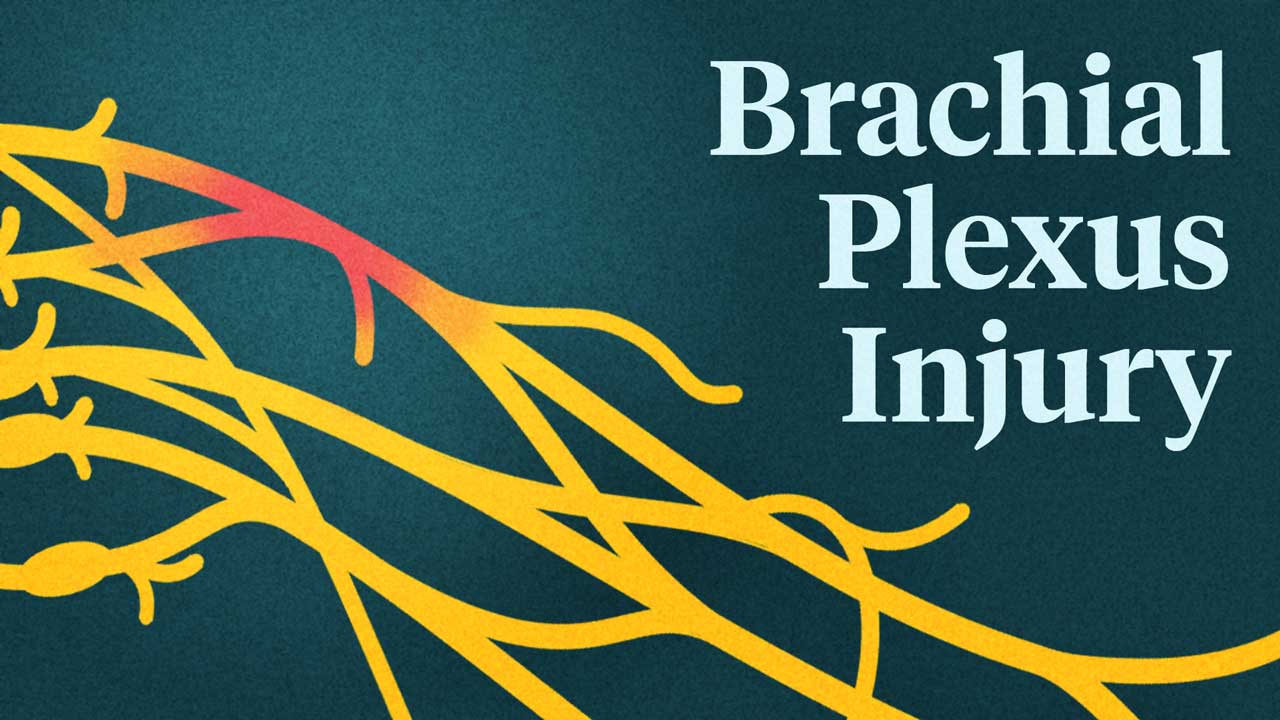The brachial plexus begins in the spinal cord at the cervical and upper thoracic region (from C5-T1) and is a system of nerves that relays messages to and from the central nervous system to the shoulder, arm and hand (Johns Hopkins Medicine 2020).
It’s a complex network that supplies the nerves to all the muscles in the upper limbs apart from the trapezius (Physiopedia 2019a). If this web of nerves is damaged, it can have potentially severe consequences for the individual.
Brachial Plexus Injuries
Often, a brachial plexus injury will occur when the nerves are stretched, compressed or torn. Signs and symptoms of brachial plexus injuries are mostly dependent on two factors: the severity of the injury and the location of the injury.
The less severe brachial plexus injuries are often those that occur from accidents such as sporting mishaps (Mayo Clinic 2022).
The symptoms experienced from these less severe injuries may last from a few seconds or minutes to a few days. People will often complain of a burning sensation or electric shock feeling down their arm and may also experience numbness and weakness in the affected arm (Mayo Clinic 2022).
The more severe brachial plexus injuries are generally those resulting from a high-level exertion of force such as that felt in a motor vehicle accident (Mayo Clinic 2022).
A total avulsion brachial plexus injury when the brachial plexus roots are ripped away from the spinal cord. The individual may be left with a paralysed arm, a significant loss of function and sensation or severe pain (Mayo Clinic 2022).

Congenital Brachial Palsy
Another way in which these injuries may occur is during birth. This is known as congenital brachial palsy or Erb's palsy and is thought to occur during the birthing process from trauma occurring to the brachial plexus.
The injury can occur to some or even all of the nerve roots of the brachial plexus, which may become stretched or ruptured during this process.
Congenital brachial palsy may present in babies as weakness of shoulder elevation and external rotation, absent biceps, absent internal rotation of the shoulder, absent elbow extension, triceps weakness, decreased wrist extension and thumb weakness.
Congenital brachial palsy occurs in approximately 0.09 to 0.26% of births (Basit et al. 2023). Risk factors include:
- Large birth weight
- Breech presentation
- Shoulder dystocia (obstructed labour where the anterior shoulder of the infant cannot pass)
- Second stage of labour > 60 minutes
- Delivery assisted by vacuum forceps
- Multipara mother
- Maternal diabetes
- Caesarean birth.
(Basit et al. 2023)
For infants with congenital brachial palsy, recovery is determined by the severity of the injury and the motor deficit. Those with a less severe motor deficit will be less likely to have a permanent significant weakness. Infants with minor injuries will frequently have a spontaneous recovery with no interventions required at all. Others may need interventions such as splinting and range of motion exercises in order to prevent contractures from occurring. Those with more severe injuries may need surgical interventions (Cassidy et al. 2022).
Other Causes
Other causes of brachial plexus injuries include radiation treatments to the chest, tumours in or along the brachial plexus and inflammation (Mayo Clinic 2022).

Treatment of Brachial Plexus Injuries
In both infants and adults, the underlying treatment principles remain the same, with the main goals of treatment being for patients to return to their previous level of function and the prevention of any potential further disability (Physiopedia 2019b).
Rehabilitation is an important component of treatment for someone with a brachial plexus injury, especially if the injury is severe. An important factor not to be overlooked in rehabilitation treatment is the patient's willingness to participate in their treatment program.
To ensure engagement, patients must be well informed about their condition, their chances of regaining back their strength and to what degree their level of function is anticipated to be following the injury.
Physiotherapy is essential to help the individual increase their strength and coordination. Occupational therapists also have an important role in assisting the individual with functional training and looking at areas such as range of motion, stamina, power and the need for any adaptive devices (Greenwood et al. 2013).
It is important that rehabilitative treatment is sought immediately following the injury. With any injury involving nerve and muscle, delayed treatment can lead to contractures forming and further disability for the individual (Greenwood et al 2013).
Surgical treatments can be used for those with severe brachial plexus injuries. These treatments cannot reconstruct the original nerve pathways, but they can help regain function by transferring and repairing nerves. These surgical repair treatments include nerve grafting and nerve transfers, among others (Luo et al. 2023; Johns Hopkins Medicine 2022).
However, like most treatment strategies, these interventions are more viable during a certain timeframe from when the injury occurred, and even with these surgeries, the individual may not not regain all function lost from the injury (Johns Hopkins Medicine 2022; OrthoInfo 2022).
Conclusion
Brachial plexus injuries can be quite debilitating for the individual. Nurses caring for these patients need to ensure they are well-informed and supported to become active participants in their care. Without this engagement, treatment can fail, leading to increases in disability for the individual and a multitude of effects on all areas of their life.
Test Your Knowledge
Question 1 of 3
True or false: Infants with minor congenital brachial palsy often recover on their own.
Topics
References
- Basit, H, Ali, CDM & Madhani, NB 2023, ‘Erb Palsy’, StatPearls, viewed 31 July 2023, https://www.ncbi.nlm.nih.gov/books/NBK513260/
- Cassidy, D, Tenaglia, A & Azizi, H 2022, Neonatal Brachial Plexus Injury, PM&R Knowledge NOW®, viewed 31 July 2023, https://now.aapmr.org/neonatal-brachial-plexus-injury/
- Greenwood, RJ, Barnes, MP, McMillan, TM, Ward, CD (eds) 2013, Handbook of Neurological Rehabilitation, 2nd edn, Psychology Press, New York.
- Johns Hopkins Medicine 2020, Brachial Plexus Injury, Johns Hopkins Medicine, viewed 31 July 2023, https://www.hopkinsmedicine.org/health/conditions-and-diseases/brachial-plexus-injuries
- Johns Hopkins Medicine 2022, Brachial Plexus Surgery, Johns Hopkins Medicine, viewed 31 July 2023, https://www.hopkinsmedicine.org/health/conditions-and-diseases/brachial-plexus-injuries/brachial-plexus-surgery
- Luo, TD, Levy, ML & Li, Z 2023, ‘Brachial Plexus Injuries’, StatPearls, viewed 31 July 2023, https://www.ncbi.nlm.nih.gov/books/NBK482305/
- Mayo Clinic 2022, Brachial Plexus Injury, Mayo Clinic, viewed 31 July 2023, https://www.mayoclinic.org/diseases-conditions/brachial-plexus-injury/symptoms-causes/syc-20350235
- OrthoInfo 2022, Brachial Plexus Injuries, American Academy of Orthopaedic Surgeons, viewed 31 July 2023, https://orthoinfo.aaos.org/en/diseases--conditions/brachial-plexus-injuries/
- OrthoInfo 2019, Erb's Palsy (Brachial Plexus Birth Palsy), American Academy of Orthopaedic Surgeons, viewed 31 July 2023, https://orthoinfo.aaos.org/en/diseases--conditions/erbs-palsy-brachial-plexus-birth-palsy
- Physiopedia 2019a, Brachial Plexus, Physiopedia, viewed 31 July 2023, https://www.physio-pedia.com/Brachial_plexus
- Physiopedia 2019b, Brachial Plexus Injury, Physiopedia, viewed 31 July 2023, https://www.physio-pedia.com/Brachial_Plexus_Injury
 New
New 
